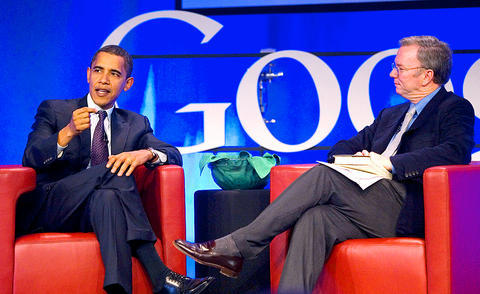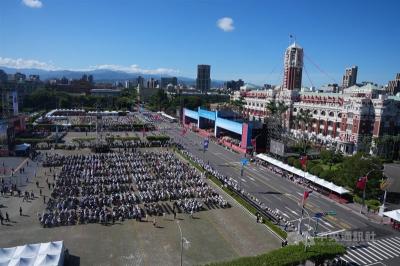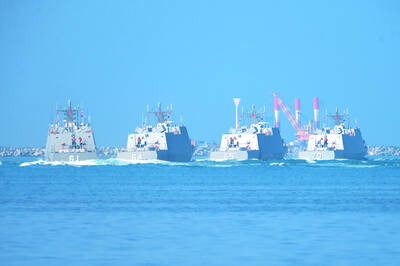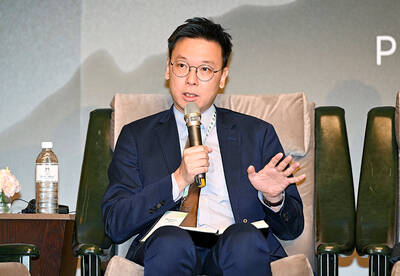Last century, General Motors (GM) assembly plants were a regular stop on the itineraries of presidential candidates. This election cycle, Google headquarters in Mountain View, California, has become a favorite destination.
Hillary Rodham Clinton made the pilgrimage in February. Then came John McCain, Bill Richardson, John Edwards, Ron Paul, Mike Gravel and most recently, Barack Obama.
In terms of theatrical symbolism, the trip to Google is similar to the GM plant visit. In both cases, the visits gave the candidate the chance for a photo opportunity at the most technologically advanced edge of the economy, "signaling identification with the future," said Kathleen Hall Jamieson, a professor at the University of Pennsylvania's Annenberg School for Communication.

PHOTO: AFP
On a more mundane level, candidates in the pre-mass-media era were concerned with reaching as many prospective voters as possible in one place, and any large factory would do.
At Google, the number of employees who can see the candidates in person is limited: The largest space at the Googleplex holds only a few hundred people.
Everyone in the 16,000-employee company can watch the event in real time over the company's internal network in their offices scattered around the globe. But Google employees, like almost everyone else, prefer the live version.
At Obama's talk last month, the atrium and overhanging balcony filled well in advance, and streams of employees poured into the building and then had to be turned away.
The politicians visiting auto plants could control what was said during the event. Today, candidates must place themselves at the tender mercies of the audience.
Those who go to Google sit exposed on the stage, without the protective lectern provided in a debate, answering questions for 45 to 60 minutes. But without the escape hatch of a timekeeper's buzzer, and as the only speaker, the candidate cannot evade uncomfortable questions. Eric Schmidt, Google's chairman and chief executive, for example, asked Obama for his views on Iran, Pakistan and Guantanamo -- and that was a single question.
The proceedings at Google are not unremittingly serious affairs. Schmidt asked McCain: "How do you determine good ways of sorting 1 million 32-bit integers in 2 megabytes of RAM?"
Immediately signaling that the question was asked in jest, Schmidt moved on. Six months later, Obama faced the same question, but his staff had prepared him. When he replied in fluent tech-speak ("A bubble sort is the wrong way to go"), the quip brought down the house.
Among the seven visiting candidates, only Obama used his Google visit to announce details of policy proposals related to technology. Until his visit, he and Edwards were widely viewed among technology bloggers as the two candidates who had the strongest positions on Internet neutrality, expanded broadband access and other technology issues.
With his Google visit, however, Obama succeeded in drawing attention to his plans for using technology to make government more accessible and transparent with, for example, live Internet feeds of all executive branch department and agency meetings. This was old-school campaigning, organized around a company visit, done well.
Though all of the candidate sessions at Google are available on YouTube, they are not YouTube-like: They require an investment of time that, by YouTube viewer standards, is inconceivable.
A 43-minute video of Clinton's Google session has been available since February and has drawn only about 54,000 "views," which count as soon as the video is begun but leave unknown the more interesting number: completed views.
Edwards' and Obama's videos, both of which run longer than an hour, have not been up as long and have still fewer viewers. The biggest draw has turned out to be for Republican Representative Ron Paul of Texas, whose July visit has been viewed, or at least started, more than 350,000 times.
For perspective, consider the numbers that short-form videos of a less serious nature draw. Search for "Barack Obama" on YouTube and you will find that the most-viewed video is titled I Got a Crush on Obama. It lacks narrative, content and anything other than a young woman with large breasts lip-synching, but it has tallied more than 4 million views.
The most-viewed video that turns up for a "Hillary Clinton" search is Vote Different, a dark parody of Apple's "1984" commercial that portrays the senator most unflatteringly, as a giant TV image that is shattered. It is also approaching 4 million views.
YouTube has a separate section, "YouChoose '08," that gives each candidate a protected space for more serious discourse, similar to the way the broadcast networks give Sunday mornings over to civic uplift. YouChoose also provides access to the CNN/YouTube debate with Republican candidates, and an earlier one with the Democrats.
Jamieson credits YouTube with broadening the range of questions in the debates, making them more memorable by having users submit the questions in the form of personal videos, and making everything searchable afterward. In the past, she said, "if you missed a debate, you missed it."
The ability to select for playback any question in the debate and the candidates' responses provides easy, precise access to the contents, sliced and diced, that was never possible before.
But it also contributes to a shortening of our collective attention span.
This is hardly new -- we've already come a long way from the Lincoln-Douglas debates of 1858 for a Senate seat, which held the audience rapt, on one occasion, for three hours -- then everyone dispersed for dinner and came back for the four-hour rebuttal.
The contrast with the public's attenuated attention in the age of television, which Neil Postman pointed out in his 1985 book Amusing Ourselves to Death: Public Discourse in the Age of Show Business, was great. The contrast is all the greater today, with the advent of the short, nonlinear clips of YouTube.
It is easy to forget that this is YouTube's first presidential campaign: The company was founded in only 2005 and acquired by Google last year.
By the time that the next campaign cycle rolls around in 2011, YouTube's influence on the culture may be so complete that a 45-minute linear video of a question-and-answer session will seem to most people to be about 43 minutes too long.
Randall Stross is an author based in Silicon Valley and a professor of business at San Jose State University.

The Ministry of the Interior (MOI) is to tighten rules for candidates running for public office, requiring them to declare that they do not hold a Chinese household registration or passport, and that they possess no other foreign citizenship. The requirement was set out in a draft amendment to the Enforcement Rules of the Public Officials Election and Recall Act (公職人員選舉罷免法 ) released by the ministry on Thursday. Under the proposal, candidates would need to make the declaration when submitting their registration forms, which would be published in the official election bulletin. The move follows the removal of several elected officials who were

The Republic of China (ROC) is celebrating its 114th Double Ten National Day today, featuring military parades and a variety of performances and speeches in front of the Presidential Office in Taipei. The Taiwan Taiko Association opened the celebrations with a 100-drummer performance, including young percussionists. As per tradition, an air force Mirage 2000 fighter jet flew over the Presidential Office as a part of the performance. The Honor Guards of the ROC and its marching band also heralded in a military parade. Students from Taichung's Shin Min High School then followed with a colorful performance using floral imagery to represent Taiwan's alternate name

FOUR DESIGNATED AREAS: Notices were issued for live-fire exercises in waters south and northwest of Penghu, northeast of Keelung and west of Kaohsiung, they said The military is planning three major annual exercises across the army, navy and air force this month, with the navy’s “Hai Chiang” (海強, “Sea Strong”) drills running from today through Thursday, the Ministry of National Defense said yesterday. The Hai Chiang exercise, which is to take place in waters surrounding Taiwan, would feature P-3C Orion maritime patrol aircraft and S-70C anti-submarine helicopters, the ministry said, adding that the drills aim to bolster the nation’s offshore defensive capabilities. China has intensified military and psychological pressure against Taiwan, repeatedly sending warplanes and vessels into areas near the nation’s air defense identification zone and across

A Chinese takeover of Taiwan would severely threaten the national security of the US, Japan, the Philippines and other nations, while global economic losses could reach US$10 trillion, National Security Council Deputy Secretary-General Lin Fei-fan (林飛帆) wrote in an article published yesterday in Foreign Affairs. “The future of Taiwan is not merely a regional concern; it is a test of whether the international order can withstand the pressure of authoritarian expansionism,” Lin wrote in the article titled “Taiwan’s Plan for Peace Through Strength — How Investments in Resilience Can Deter Beijing.” Chinese President Xi Jinping’s (習近平) intent to take Taiwan by force